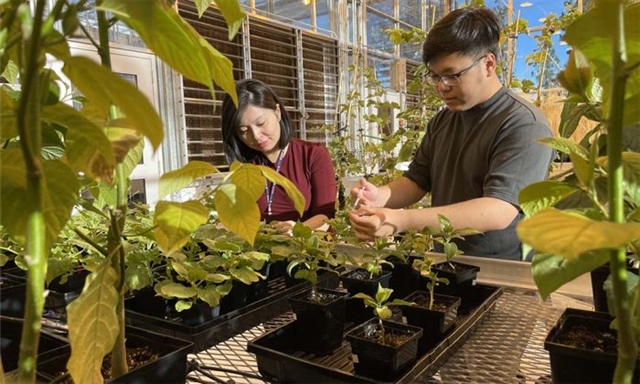
HÀ NỘI — “Why do plants use water, light and air to produce compounds that have the potential to treat complex diseases like cancer?”
It was this question that took Dr Đặng Thị Thu Thủy on the path of researching the biosynthesis of substances in plants.
Thanks to the work, she discovered mysteries of the plant world.
Thủy thinks that learning about the biosynthesis of natural compounds is an endless journey, in which each discovery will open a new and interesting branch.
On this journey, her starting point also came quite unexpectedly.
She was used to using plants to treat diseases in her childhood, and has been interested in medicinal plants since she was a student. But it was not until she was studying for a master’s degree at the University of Calgary in Alberta, Canada and saw research on the biosynthesis of compounds in plants, she realised that beyond the very basics she had learned about plant physiology, there are a variety of avenues to explore.
She told the Khoa học & Phát triển (Science and Development) e-newspaper that this was the reason why she carried out a doctoral research project with Prof Peter Facchini, a leading expert in opium biochemistry, with a scholarship from the Alberta Ingenuity Fund and two PhD scholarships from the University of Calgary.
After studying in Canada, she won a postdoctoral fellowship from the European Molecular Biology Organisation (EMBO) to join a laboratory at the John Innes Centre in the UK with Prof Sarah O’Conor, an outstanding scientist with more than 10 years of research on vinblastine biosynthesis in periwinkle.
“Nature, especially plants, has the ability to create many drugs and chemical compounds with great value,” said Thủy.
“If you consider these molecules as houses, plants have all kinds of enzymes to build the foundation, erect the trusses, roof, build walls, and then decorate the interior and exterior fully.
“What I do is figure out what those enzymes are, and in what order plants use them, and then I can frame my own house, structure it, and decorate it the way plants do or even even according to my own will.”
These are the basic insights used so that Thủy and her colleagues can repeat the process of creating their desired natural ingredients in the laboratory without having to over-explore rare plant resources or use to harmful chemicals.
Her own way
Experience and knowledge gained from teachers and research institutions from Việt Nam to Canada and the UK helped Thủy forge her own path, establishing the Plant Bioactive Compounds Research Laboratory at the University of British Columbia in Kelowna City, Canada.
In the lab, she and her colleagues integrate biochemistry, chemistry, bioinformatics and molecular genetics to explain and explore the biosynthesis of valuable compounds in herbs.
This is a relatively new research direction with many attractive opportunities, the level of competition is also increasing. With a newly established laboratory, the pressure of having to race against experienced teams with lots of talent and full equipment is great.
“It’s simply that the compounds I find exciting are also found exciting by other research groups around the world,” she said.
Thinking about the long term, she is gradually building up her lab’s capacity, trying to bring in many people with different expertise so that when they gather together, they will solve problems faster and solve bigger problems.
The diversity of specialties also gives everyone in the group the opportunity to learn from each other and open up new directions in the research process.
After more than two years, Thủy’s research team has obtained new results on the metabolism of anti-cancer chemicals from hỷ thụ, whose scientific name is Campotheca acuminata.
Hỷ thụ is a woody plant that has been used as medicine in East Asian countries for a long time. Modern pharmacology proves that camptothecin compound from hỷ thụ is effective in treating many types of cancer such as lung cancer, ovarian cancer, and colorectal cancer. However, camptothecin is difficult to dissolve in water and has many side effects.
So far camptothecin had to be oxidised and undergone many transformations by complex chemical methods, which are harmful to the environment, to create suitable drugs for treatment.
Thủy’s research group has found substances which are capable of oxidising campothecin only by yeast.
This result not only helps the team publish in international journals but also register a patent.
“The patent application process is supported by the University of British Columbia and has completed its first phase,” said Thủy.
“Natural plants are great doctors, and Việt Nam has many such ‘great doctors’.”
Thủy has followed and talked with herbalists from the Hà Nội University of Pharmacy, the University of Natural Sciences under HCM City National University, and the Central Highlands Scientific Research Institute. She found many important research results.
“I look forward to contributing to enriching applications from Vietnamese plants from my perspective,” said Thủy. — VnExpress News
- Reduce Hair Loss with PURA D’OR Gold Label Shampoo
- Castor Oil Has Made a “Huge” Difference With Hair and Brow Growth
- Excessive hair loss in men: Signs of illness that cannot be subjective
- Dịch Vụ SEO Website ở Los Angeles, CA: đưa trang web doanh nghiệp bạn lên top Google
- Nails Salon Sierra Madre
 VnExpress News The News Gateway of Vietnam
VnExpress News The News Gateway of Vietnam





